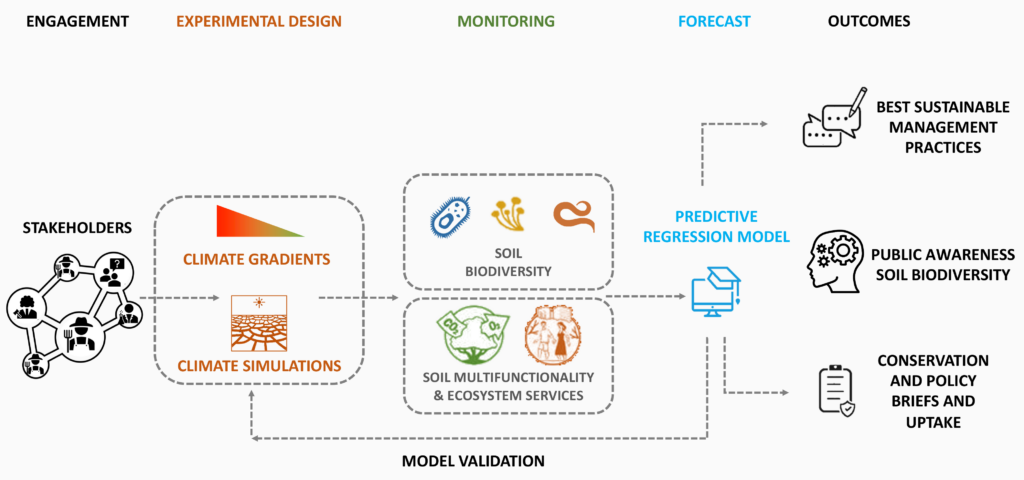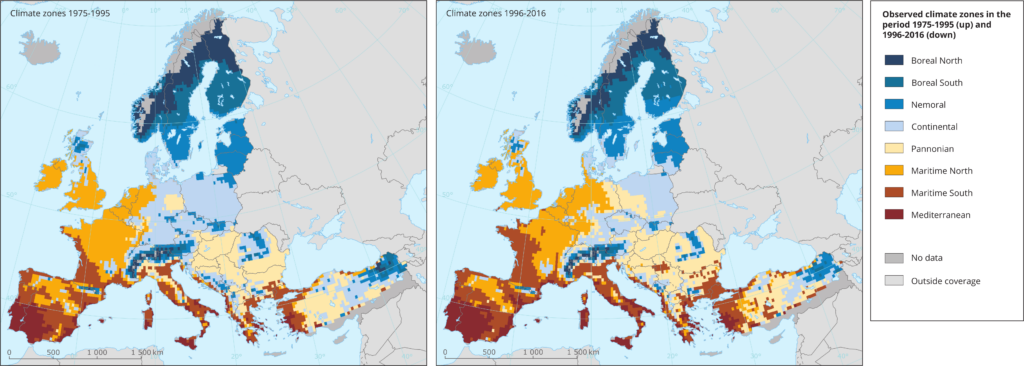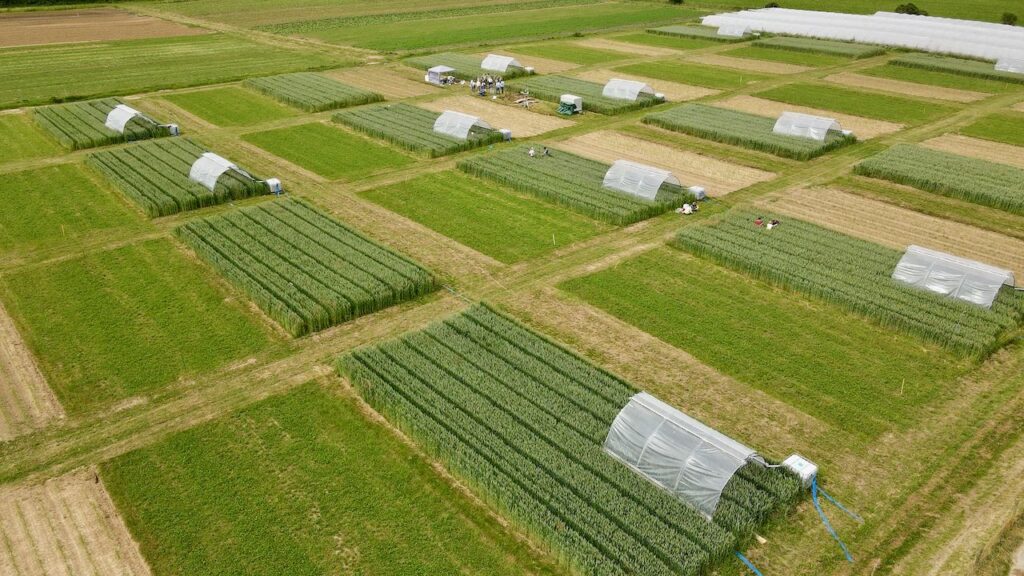In order to achieve its goals, MICROSERVICES is divided into 6 different thematic work packages (WP) that all work in conjunction with each other to better understand the impact of climate change on crop microbiomes.
- WP1: Project management & stakeholder involvement
- WP2: Regional climate predictions based on Earth Observation data
- WP3: Assessment of wheat microbiomes along climate gradients
- WP4: Experimental drought under conventional & organic farming
- WP5: Machine learning predictions of climate change impacts
- WP6: Dissemination, outreach, and policy impact
WP1: Project Management & Stakeholder Involvement
AIM: Coordinating and managing project strategies and activities; establishing European-wide project-compatible stakeholder network
DESCRIPTION: ETH will coordinate and manage the project, promote efficient execution of all planned activities, oversee the work, ensure proper communication among the project partner, amongst many others. ELO, on the other hand, will lead the stakeholder involvement part.
LEAD: ETH & ELO

WP2: Regional climate predictions based on EO-data
AIM: Provisioning of regional climate projects; identification of European ecoregions with forecasted climate progression; final selection of sites via stakeholder engagement.
DESCRIPTION: Plain raw data retrieved from Copernicus, one of Europe’s largest investment programmes, gains value once analysed and enriched with data. The Copernicus Climate Change services collect a pool of data to monitor the climate and predict how it will change in the future, with applications assessing and mapping the continuing northward migration of agro-climate zones in Europe over the past decade as well as forecasting such shifts over the next decades. This information can be utilised to examine climate change impacts across humanity activities, for example in the case of MICROSERVICES in regards to soil microbial diversity across shifting climatic zones.
NOA is developing regional climate models to identify climatically distinct ecoregions across the continent, where forecasted progressions in climate change predict that a specific ecoregion will become climatically significant to another one in the future to the northward migration of climatic conditions. Hopefully, within each ecoregion, multiple wheat sites will be identified that also cover – as far as possible – different agricultural management regimes.
LEAD: NOA

WP3: Assessment of wheat microbiomes along climate gradients
AIM: Assessing diversity of wheat-associated microbiomes, wheat microbiome interactions, and ecosystem multifunctionality across the climate gradients.
DESCRIPTION: Exploring and understanding cases in which microbiome data can be integrated into ‘smart farming’ practices is only just beginning. Following the advent of next-generation DNA sequencing, researchers have started characterizing microbial communities associated with wheat and other crops: soil type, management regime, and crop genotype have been shown to shape these microbiomes. Climate change is also another factor affecting plant-microbe interactions, in the form of altering carbon and nitrogen fluxes, with such interactions turning modulate resistance and resilience of crops towards climate change stressors.
However, one major limitation of studies on the effects of climate change on microbial diversity and abundance is that they ignore region-specific climate change traits and the interactive aspects of microbial communities, crops, and ecosystem functions and services.
Soil samples collected across the continent will be sent to WP leader, INRAE (French National Institute of Agricultural and Environmental Research) in Dijon for downstream analysis. Further analysis will be split between ETH (Swiss Federal Institute of Technology) Zurich in collaboration with LEITAT Technological Center, as well as UoK (University of Kassel). Combined, these analyses will assess ecosystem multifunctionality, covering several ecosystem services (e.g. food and fibre production, soil fertility and nutrient cycling, climate regulation etc.). Statistical analysis will be performed to assess biodiversity shifts and ecosystem multifunctionality.
LEAD: INRAE
WP4: Experimental drought under conventional & organic farming
AIM: Assessing the impact of simulated drought on the crop-soil-microbiome nexus in a long-term agricultural field experiment; evaluating the capacity of organic agricultural practice to increase resistance and resilience of the crop-soil-microbiome nexus towards drought.
DESCRIPTION: Intensive industrial agriculture has led to an oversimplification of agricultural ecosystems and a decrease in soil fertility across Europe, resulting in a loss of aboveground biodiversity and the streamlined flow of nutrients and energy through the system. In the context of climate change, conservational practices (ones that enhance soil biodiversity and its functions through agroecosystem diversification) also aim at increasing climate resilience (adaptation) and reducing the contribution of agricultural practices to greenhouse gas emissions (mitigation).
Led by ETH & Agroscope and in close collaboration with the Institute of Organic Agriculture (FiBL), the impact of drought under conventional and organic farming regimes will be simulated in rainout-shelters within the DOK agricultural long-term trial in Switzerland. The DOK is an experiment that compares biodynamic, organic, and conventional cultivation of arable crops (i.e. wheat, potatoes, maize, etc.) since 1978 at the same site. This provides a unique opportunity in assessing the long-term impacts of various agricultural practices on various ecosystem functionalities. The DOK was chosen to assess the impact of drought as an important future climatic event linked to climate change on the crop-soil-microbiome nexus. Rainout sheltering will take place during the main growing season. Soil samples from the DOK will be analysed in coordination between ETH, Agroscope, UoK, INRAE, and LEITAT.
LEAD: UoK & AGROSCOPE

WP5: Machine learning predictions of climate change impacts
AIM: Developing a machine learning-based regression model to pave the way for future tools to accurately forecast region-specific soil biodiversity dynamics and cascading effects on key ecosystem services in agricultural systems under future environment conditions.
DESCRIPTION: Artificial intelligence in the form of machine learning algorithms is enabling real-time diagnostics and forecast of crop physiological conditions based on climate and soil physiochemical data. However, there are very few studies on assessing the potential of such algorithms being used to predict crop productivity thanks to soil microbiome parameters. MICROSERVICES will evaluate the potential of machine learning to combine region-specific climate change models, rhizosphere, microbiome diversity, adaptive plant traits, and ecosystem services data to generate an algorithm capable of forecasting the effect of future environmental scenarios to ecosystem functionality. Further down the line, policymakers and key stakeholders across jurisdictions can benefit from this information by obtaining predictions of biodiversity shifts and their resulting consequences for agriculture under future climatic scenarios.
Data across the various work packages will be harmonised and formatted for subsequent analysis by LEITAT alongside NOA. A single data structure will be created, containing information about soil sites, climate, biodiversity, and ecosystem multifunctionality. Patterns and correlations defined among region-specific climate conditions, microbial diversity, and ecosystem multifunctionality will be used as a starting point for modelling a predicted regression algorithm. The accuracy in predicting ecosystem services dynamics in relation to climate conditions and microbial diversity will be validated with data from the work done at the DOK in Switzerland.
LEAD: LEITAT
WP6: Dissemination, Outreach, and Policy Impact
AIM: Disseminating research findings to the scientific community and stakeholders; transforming project results to impact policy agendas;reaching out to the public to increase awareness among society.
DESCRIPTION: WP6 will make the results operative and accessible for a wide range of stakeholders by focusing on communication and outreach in a collaborative framework. ELO (the European Landowners’ Organization) will lead this work package. Alongside stakeholders and policymakers, MICROSERVICES project partners will impact ongoing policy debates on climate action by highlighting both the short- and long-term implication of MICROSERVICES results. These will then be implemented at the national and European level through a wide range of channels and tools.
LEAD: ETH & ELO
Interconnectivity Amongst Work Packages (WP)
The MICROSERVICES project is a multidisciplinary project, bringing together various types of expertise and methodological knowledge in order to tackle a global challenge.
Indeed, addressing global sustainability related issues, at the intersection of the economy, society, and the environment, requires refining the institutional research structure and leveraging global expertise and know-how through a transnational approach. Not only does a multidisciplinary approach bring in actors from, in this case, across Europe, but also from across disciplines. The vast majority of global and even regional issues, such as climate threats on soil biodiversity, can only be addressed through a collective approach across disciplines. This allows for more accurate guidance when it comes to shaping climate change adaptation strategies.
Within the MICROSERVICES consortium, consortium members cover a wide range of expertise:
- Earth observation (EO) based climate modelling to predict region-specific future climatic conditions across Europe (WP2);
- Various molecular technologies that monitor diversity and functioning of crop-associated microbiome and their interactions under natural and simulated climatic conditions (WP3 and WP4, respectively);
- Machine learning regression models that have the ability to forecast the delivery of ecosystem services by the crop microbiomes within different future climatic conditions (WP5);
- Participatory methods in order to engage with an extensive network of both stakeholders and policymakers across the continent (WP6).
More specifically, the project brings together individuals with a specific set of skills, from environmental sciences (microbial ecology, crop physiology, agronomy, and climatology), computation sciences (bioinformatics, statistics, climate modelling, and artificial intelligence), to social sciences (communication and dissemination).
This way, project results can be translated into information that can help achieving EU-wide goals, such as, but as not limited to, Aichi Biodiversity Target 7, SDG 15, as well as bringing the focus to microbiomes for the post-2020 global biodiversity agenda. This transnational, multidisciplinary aspect brings much added value, which directly fosters contributing to the European territorial strategy and policy, establishing partnerships for future projects, as well as examines the potential of improving Europe’s competitiveness by opening new markets related to biodiversity and computational science. On top of this, the indirect added value of having such a transnational team relies on considering differentiating view points of project partners as a strength and source of additional knowledge, fostering a European identity through research, and acquiring a new set of skills and capacities that can influence decision making processes across scales.

Long-term Societal and Political Implications
Microbial diversity provides a wide range of both direct and indirect services to human activities and livelihoods, including soil formation, nitrogen fixation, bioremediation, biotechnology, and biocontrol. To put into context, these benefits amount to approximately 1.16 trillionUS dollars globally, per year, which is equivalent to one third of the estimated contribution of terrestrial ecosystem services per year to the global economy.
However, such benefits are under threat due to climate change and human activities such as intensive use of agrochemicals in agroecosystems as well as ineffective soil management. This situation is putting policymakers as well as scientists into a state of search for more sustainable and environmentally friendly resource management strategies across the European agricultural landscape.
Active and diverse soil microbiomes are crucial for maintaining crop productivity, and quality, as well as maintaining such positive aspects is essential for sustainable farming strategies within the context of climate change mitigation and adaptation strategies. Down the line, such positive attributes of soil microbiomes contribute to establishing and maintaining a healthy, resilient, and sustainable food production system as well as assist in maintaining (and possible even increasing) agricultural productivity and yields, contributing in the short-term to farmers’ livelihoods as well as in the long-term, contributing to a resilient and prosperous agricultural sector.
One of the goals of the project is to increase the awareness of agricultural stakeholders’ awareness on the importance of maintaining and protecting life belowground, and maintaining its diversity that can have long term positive impacts on environmental, economic, and social dynamics of both rural and urban societies. Combining this aspect with the use of novel technologies such as machine learning to forecast shifts in microbiomes and map potential future scenarios accordingly, can assist agricultural management strategists and make more informed and accurate decisions, which can then later increase the impact of biodiversity research on the relevant policymakers. MICROSERVICES aims to, directly and indirectly, contribute soil microbial diversity to the following policy debates surrounding climate action and aching sustainability goals:
- Paris agreement of 2015;
- National Common Agricultural Policy (CAP) strategies plans;
- Aichi Biodiversity Targets;
- SDGs;
- EU Pollinator Initiative;
- Post-2020 Global Biodiversity Framework.